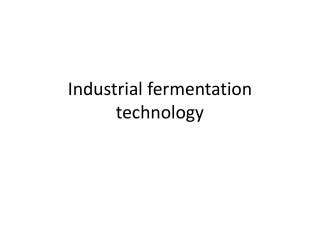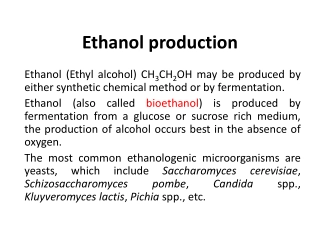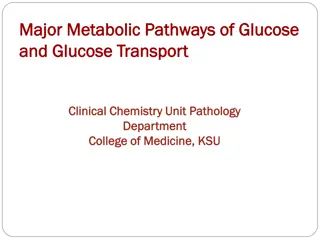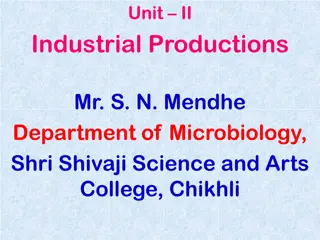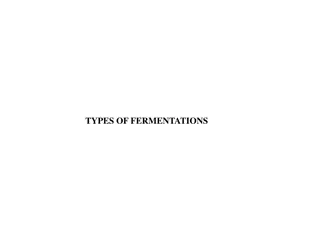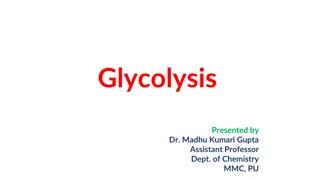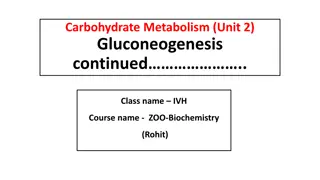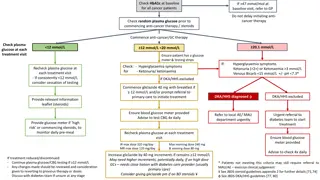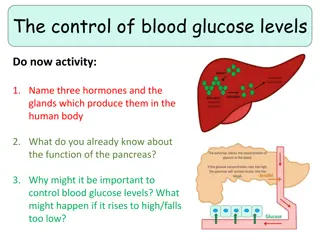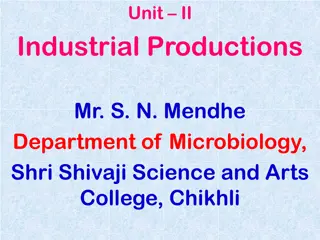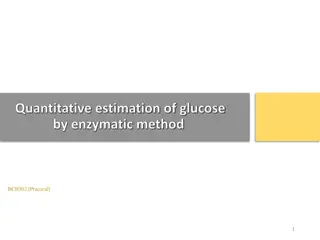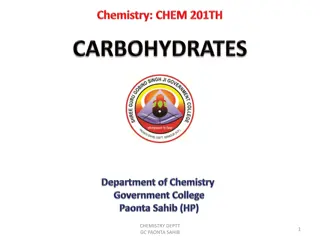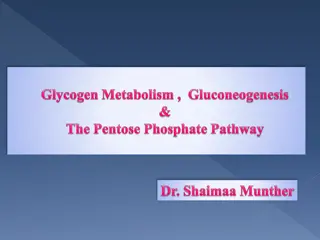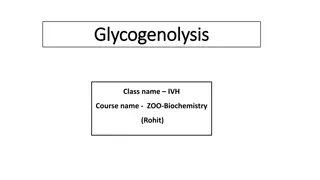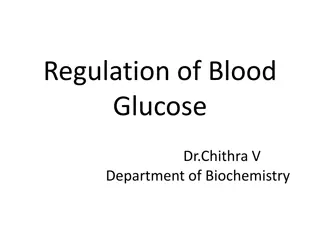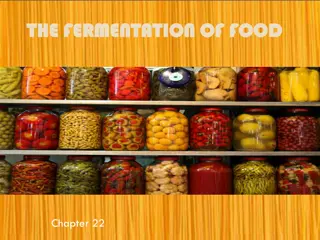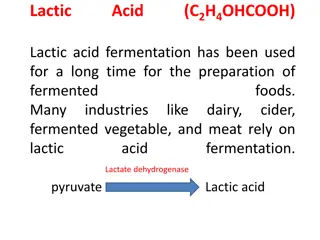Production of Pyruvate and Acetaldehyde in Glucose Fermentation
Two metabolic pathways for glucose breakdown, glycolysis and gluconeogenesis, are explored, focusing on the production of pyruvate and acetaldehyde during yeast fermentation. The process involves blocking enzymes, using inhibitors, and changing physiological conditions to study intermediates like pyruvate and acetaldehyde. Experimental methods with sodium nitroprusside and sodium sulfate are employed to demonstrate the presence of these compounds.
Download Presentation

Please find below an Image/Link to download the presentation.
The content on the website is provided AS IS for your information and personal use only. It may not be sold, licensed, or shared on other websites without obtaining consent from the author.If you encounter any issues during the download, it is possible that the publisher has removed the file from their server.
You are allowed to download the files provided on this website for personal or commercial use, subject to the condition that they are used lawfully. All files are the property of their respective owners.
The content on the website is provided AS IS for your information and personal use only. It may not be sold, licensed, or shared on other websites without obtaining consent from the author.
E N D
Presentation Transcript
CLS 331 Exp no. 3 The Production of Pyruvate and acetaldehyde during the fermentation of glucose by Yeast
There are 2 metabolic pathways for breakdown of glucose :
1- Glycolysis a metabolic process that breaks down glucose through a series of reactions and releases energy for the body in the form of ATP. Under aerobic conditions : Glucose 10 steps Pyruvate (in animal &yeast) Under anaerobic conditions: Animals: Glucose Pyruvate Lactate Yeast: Glucose Pyruvate Acetaldehyde Alcohol
2- Gluconeogenesis Is a metabolic pathway that results in the generation of glucose from non-carbohydrate carbon substrates such as lactate, glycerol.
In Glycolysis: Glucose Pyruvate (in animals &Yeast) Under anaerobic conditions: Animals: Glucose Pyruvate Lactate Yeast: Glucose Pyruvate Acetaldehyde Alcohol Alcohol is formed in yeast by the oxidative decarboxylation of pyruvate with the intermediate formation of acetaldehyde. They normally present at low conc.
So to demonstrate their existence as intermediates on the pathway, some means has to be found to prevent the reaction proceeding any further. Blocking the enzyme that catalyses the conversion of the compound under investigation by: -Adding an inhibitor -Changing the physiological conditions (pH, temperature) -Adding trapping agent which reacts with intermediate to form a compound that is not metabolized further. Glucose Pyruvate Acetaldehyde Alcohol Pyruvate decarboxylase
Pyruvate decarboxylase is inactive in slightly alkaline solution so pyruvate accumulates and its presence is demonstrated by the reaction with sodium nitroprusside or 2,4-dini-trophenylhydrazine. In the 2nd experiment, sodium sulphate is added which traps the acetaldehyde. The presence of acetaldehyde is shown by blue colour produced with sodium nitroprusside and piperidine.
-Formation of pyruvate from glucose http://t2.gstatic.com/images?q=tbn:4_NKSX8VJ3Lw3M:http://www.saratogaschools.org/AcademicServices/MiddleSchool/MSScience/Science_Lab_Equipment-Flashcards/testtube1.jpg A http://t2.gstatic.com/images?q=tbn:4_NKSX8VJ3Lw3M:http://www.saratogaschools.org/AcademicServices/MiddleSchool/MSScience/Science_Lab_Equipment-Flashcards/testtube1.jpg B 10% glucose 5ml 5ml Alkaline yeast suspension acidic yeast suspension 5ml -------- ---------- 5ml Mix and incubate in water bath at 37 C for 1 hour
- Add 2ml of TCA ( trichloracetic acid) for each tubes - Mix and centrifuge for 10 min at 2500 g. - Remove the supernatant - Boil about 3ml of supernatant for 5 min.
- Sodium nitroprusside test for pyruvate http://t2.gstatic.com/images?q=tbn:4_NKSX8VJ3Lw3M:http://www.saratogaschools.org/AcademicServices/MiddleSchool/MSScience/Science_Lab_Equipment-Flashcards/testtube1.jpg B1 http://t2.gstatic.com/images?q=tbn:4_NKSX8VJ3Lw3M:http://www.saratogaschools.org/AcademicServices/MiddleSchool/MSScience/Science_Lab_Equipment-Flashcards/testtube1.jpg A1 solid ammonium sulphate Supernatant A inch (0.5g) inch (0.5g) 2ml (boiled) supernatant B 2ml(boiled) 5% nitroprusside sol. 2 drops 2 drops Mix
Add conc. ammonia carefully down the side of the tube so as to form 2 layers. If pyruvate is present, a green or blue ring forms at the junction of the 2 liquids. A transient pink ring at the junction is due to the presence of thiol group
- Test for pyruvate with 2,4-dini-trophenylhydrazine A B inch of solid ammonium sulphate http://t2.gstatic.com/images?q=tbn:4_NKSX8VJ3Lw3M:http://www.saratogaschools.org/AcademicServices/MiddleSchool/MSScience/Science_Lab_Equipment-Flashcards/testtube1.jpg http://t2.gstatic.com/images?q=tbn:4_NKSX8VJ3Lw3M:http://www.saratogaschools.org/AcademicServices/MiddleSchool/MSScience/Science_Lab_Equipment-Flashcards/testtube1.jpg 2ml of supernatant A 2ml of supernatant B 1ml of 2,4-dini- trophenylhydrazine 1ml of 2,4-dini- trophenylhydrazine Mix
A1 B1 http://t2.gstatic.com/images?q=tbn:4_NKSX8VJ3Lw3M:http://www.saratogaschools.org/AcademicServices/MiddleSchool/MSScience/Science_Lab_Equipment-Flashcards/testtube1.jpg 1 ml NaOH 2 or 3 drops of the mixture A http://t2.gstatic.com/images?q=tbn:4_NKSX8VJ3Lw3M:http://www.saratogaschools.org/AcademicServices/MiddleSchool/MSScience/Science_Lab_Equipment-Flashcards/testtube1.jpg 2 or 3 drops of the mixture B 2ml water A red colour forms if pyruvate is present
Formation of acetaldehyde from glucose C http://t2.gstatic.com/images?q=tbn:4_NKSX8VJ3Lw3M:http://www.saratogaschools.org/AcademicServices/MiddleSchool/MSScience/Science_Lab_Equipment-Flashcards/testtube1.jpg D http://t2.gstatic.com/images?q=tbn:4_NKSX8VJ3Lw3M:http://www.saratogaschools.org/AcademicServices/MiddleSchool/MSScience/Science_Lab_Equipment-Flashcards/testtube1.jpg 5ml of glucose solution 0.5 g of sodium sulphite (trapping agent) 5ml of yeast suspension Mix Incubate the two tubes at 37 C for 1h


